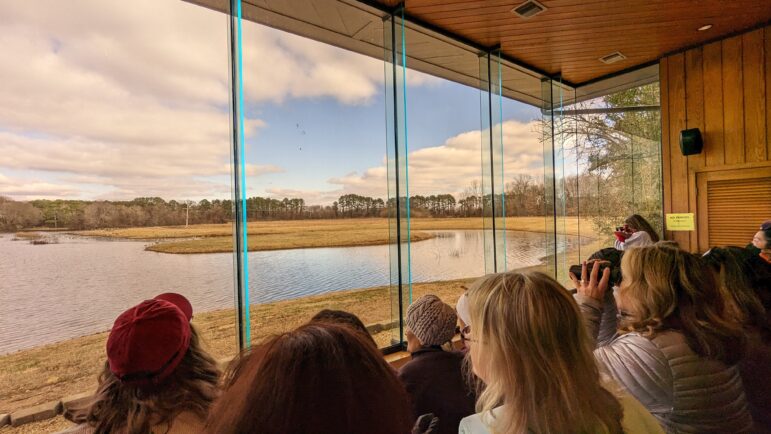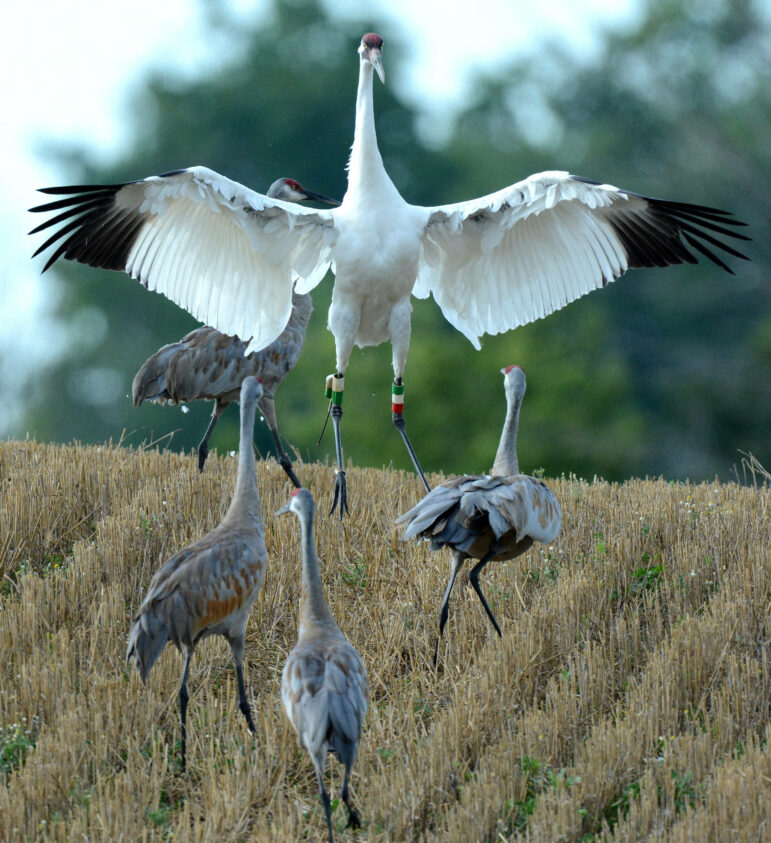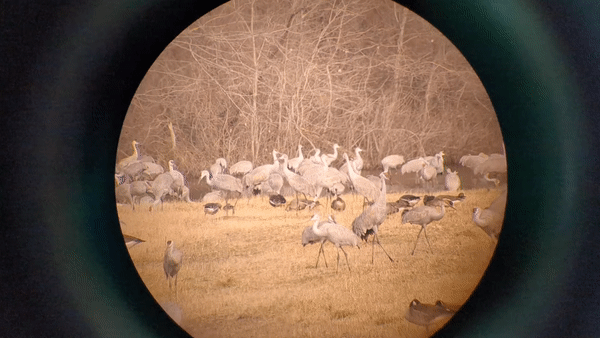This swampy paradise is Alabama’s winter haven for sandhill cranes
As many as 25,000 sandhill cranes migrate to Wheeler National Wildlife Refuge every winter, along with a handful of highly endangered whooping cranes.
This story is part of a monthly series called Outdoor Connections, which features stories that explore the biodiversity of Alabama and how we depend on it.
Walking along the gravel paths of Wheeler National Wildlife Refuge, park ranger David Young looks to the sky as a flock of sandhill cranes soars overhead, emitting a loud chorus of sounds.
“I just love that call. It’s very dinosaur-like,” Young said.
With a wingspan that measures up to five feet, sandhill cranes typically have gray feathers, with a bright red patch on their foreheads.
As the birds fly in unison, they stretch out their long thin necks and point their skinny legs behind them, enjoying a chilly day on the swampy refuge in Decatur.
“We have three things that they really like,” Young said. “We have water. We have open fields that are relatively undisturbed. And we have the groceries. We have the food.”
With 35,000 acres nestled near the Tennessee River, Wheeler staff work with cooperative farmers to grow crops like corn, leaving behind a portion for the cranes to forage.
The refuge is home to hundreds of diverse species of birds, fish, reptiles, mussels and more. But the cranes bring the crowds.
As many as 25,000 sandhills migrate to Wheeler every winter, along with a handful of highly endangered whooping cranes.
Nature enthusiasts can visit the refuge throughout the season to catch a glimpse of the tall waterfowl. But the annual Crane Festival, hosted with assistance from the Wheeler Wildlife Refuge Association, is set aside every January to observe and celebrate the birds.

“It’s been great,” said nine-year-old Lara Badri of Nashville, who attended the festival with her family. “I saw a lot of sandhills. But I’ve been trying to see whooping cranes.”
Compared to the sandhills, whooping cranes are about a foot taller, with bright white feathers. And they’re much less common.
Highly endangered, there are approximately 836 whooping cranes in the world, according to the International Crane Foundation (ICF), a non-profit that works to protect and reintroduce the species worldwide. Current numbers, while low, reflect decades of conservation efforts, rebounding from a population of fewer than 20 birds in 1941.

“Once I heard they actually got revived by scientists, I’ve always wanted to see one,” Badri said.
This year, 13 of the rare birds have been spotted on the refuge, a few less than past seasons.
Legina Jenkins, a volunteer with ICF, spends the winter months driving across north Alabama looking for the whooping cranes. She knows each bird’s quirks.
“There’s four of them that stay together. I refer to them as the fab four,” Jenkins said. “Then there’s one that stays at the visitors center all by herself with the sandhills. And then there’s another pair that stays in a real secluded area. They don’t like company. They stay real isolated.”
Jenkins said one of the female cranes returned this year without her mate, who appears to have gone missing during migration.
“We’re really afraid that something’s happened to him, but we don’t know for sure,” Jenkins said.
Both whooping cranes and sandhill cranes typically mate for life, and they both have a robust collection of dance moves they use to communicate.
The refuge is equipped with outdoor viewing platforms, boardwalks and an indoor observation deck for visitors to observe the birds in action.
While spotting a whooping crane is difficult, bird watchers are rewarded with hundreds, if not thousands, of sandhill cranes that gather together across miles of wetlands.
“There’s a lot of them,” said Danielle Ford of Harvest. “I was interested to see, when we were driving up, the big flock of them. I was like ‘wow.’ I hadn’t seen that many at one time.”

Sandhill cranes are numerous now, with more than 500,000 birds worldwide, but the species was also once near extinction, the result of habitat loss and overhunting about a century ago.
The species recovered thanks to conservation efforts, so much so that a few years ago, Alabama reinstated a sandhill hunting season, although no hunting is allowed on the refuge.
Both the sandhill and the whooping cranes are expected to stay at Wheeler for a few more weeks before heading back north.
Do you have an idea worth featuring as part of our Outdoor Connections series? Email maryscott@wbhm.org.
How a third parent’s DNA can prevent an inherited disease
An experimental technique that patches defective DNA with donated genetic material helped families at risk of passing rare illnesses to their children.
A dentist is on trial for allegedly killing his wife with poisoned protein shakes
James Craig is accused of fatally poisoning his wife of 23 years and trying to cover his tracks by asking his cellmate to kill the lead investigator. Here's what to know as his Colorado trial starts.
Drake, Toby Keith and ‘KPop Demon Hunters’ have a big week on the charts
It's a slow week on the Billboard charts, but a few albums and singles are still having a huge impact, including Drake's new single "What Did I Miss?" and the soundtrack to the Netflix original movie KPop Demon Hunters.
‘Sorry, Baby’ is a story about pain and healing you haven’t heard before
Eva Victor wrote, directed and stars in this tender film about a woman trying to make sense of life after sexual assault. Although very much a drama, Sorry, Baby showcases Victor's comic smarts.
Greetings from New Delhi, India, where performing monkeys spark delight — and ambivalence
Far-Flung Postcards is a weekly series in which NPR's international team shares moments from their lives and work around the world.
Israel strikes Syria’s capital Damascus
The Israel military said targets included a Syrian military compound in Damascus as well as a target near the Syrian presidential palace. Israel's defense minister said "painful strikes have begun."







